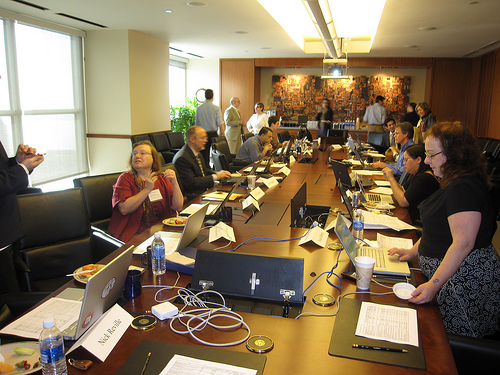
Not Me, But I've Got a 1976 Version of This Pic Somewhere
We all know business is bad. The question local newsers need to ask themselves is this: will it ever get better?
Is local television down thanks to market forces, which would leave hope of a rebound and a return to better days? Or is this more than market-driven, but a generational change–a shift in media habits that casts once dominant local TV stations as latter day vaudeville acts, doomed to ever-diminishing returns and ultimate irrelevance?
I grew up around and inside television stations and have loved the buildings, the logos and the lore as long as I can remember. I have treasured pictures of myself as a kid at WCAU, wearing a 70s era headset and posing for a picture at the studio camera. Years later, as a high school kid, I posed for a picture with a friend on the news set at WCBS. Stations are in my blood, and that’s not going to change.
But I’m sure generations of kids grew up in families dominated by Detroit, developing a love for cars, hood ornaments and engines, and sadly, nostalgia alone won’t save GM. I think stations are in just as much trouble, if not more.
TV Newsday wrote up the sagging situation last week, reporting on revenues for the top 50 broadcast companies. “Gainers Rare” read the headline. In fact, “decliners led advancers” as the market types say, in a blowout: 44 of the top 50 companies lost money in 2008, and some lost a LOT.
Sunbelt, owner of nine stations including KVBC in Las Vegas, fell 20 percent from 2007. Sunbeam (best to avoid using any derivation of “sun” in your name) dropped 15 percent. There were bright lights, though, with six companies posting modest gains.
McGraw-Hill was up 6.26 percent in 2008 (but nosedived 23 percent in 1Q 2009); Post-Newsweek was up 3.59 percent in 2008 (but down 21 percent in 1Q 2009); and Capitol was up over eight percent last year, leading CEO Jim Goodman to tell reporters at NAB in April that “the best is yet to come” for broadcasters, reported Broadcast Engineering. The DTV transition, Goodman argued, meant good things for the future of over-the-air TV.
I’m not convinced.

Anybody Else Remember WCBS and These Wild Desks? I Do.
In an excellent article on MediaPost, Diane Mermigas reports station revenues will likely fall to 1995 levels this year, and no, the money-printing machine will not be working normally when the recession ends. “TV stations’ ability to excel in the nascent but promising world of hyperlocal information and services is hindered by a slew of uncontrollable forces. There is the collapse of core ad categories, such as automotives, which has contributed about one-fourth of all TV station revenues and will never fully recover. Internet-connected streaming video for PCs and mobile devices will continue to minimize and fragment television. Despite massive reductions in workforce and legacy operations, the pooling of local news-gathering and ad sales resources, and a growing Web presence, TV stations’ economic quandary increasingly mirrors that of declining newspapers,” Mermigas reports.
“Despite the most optimistic forecasts — more than 12 legacy broadcast companies generate between $10 million and $311 million in annual revenues from the sale of online advertising, per Borrell Associates — there is no way to effectively offset lost ad dollars, some of which are not coming back.”
Can stations–facing permanent declines–innovate their way back to profit? I say no. I’ll be laying out my argument in a series of “SlimeWatch” reports here. The reference to slime is not intended to suggest any malfeasance or filth, but rather, a reference to Rishad Tobaccowala, who has argued persuasively that the innovation that will save local journalism will almost certainly NOT come from existing broadcast companies.
I encourage you to watch this video and listen to what he has to say. Then let me know what you think: can stations find a way into the future? Or are they wearing cinder block shoes?


 Everybody in town isn’t coming out of this alive, folks. And assuming the print people will roll over and play dead just because, you know, the printing press is dead, well, that doesn’t seem to be working. Sure, the paper won’t be hitting doorsteps like it used to, but those print folk seem so aggressive about getting into our game. And far moreso than we seem to be about getting into theirs. Or even, about getting more creative about what we do. And that’s how companies go out of business.
Everybody in town isn’t coming out of this alive, folks. And assuming the print people will roll over and play dead just because, you know, the printing press is dead, well, that doesn’t seem to be working. Sure, the paper won’t be hitting doorsteps like it used to, but those print folk seem so aggressive about getting into our game. And far moreso than we seem to be about getting into theirs. Or even, about getting more creative about what we do. And that’s how companies go out of business.






